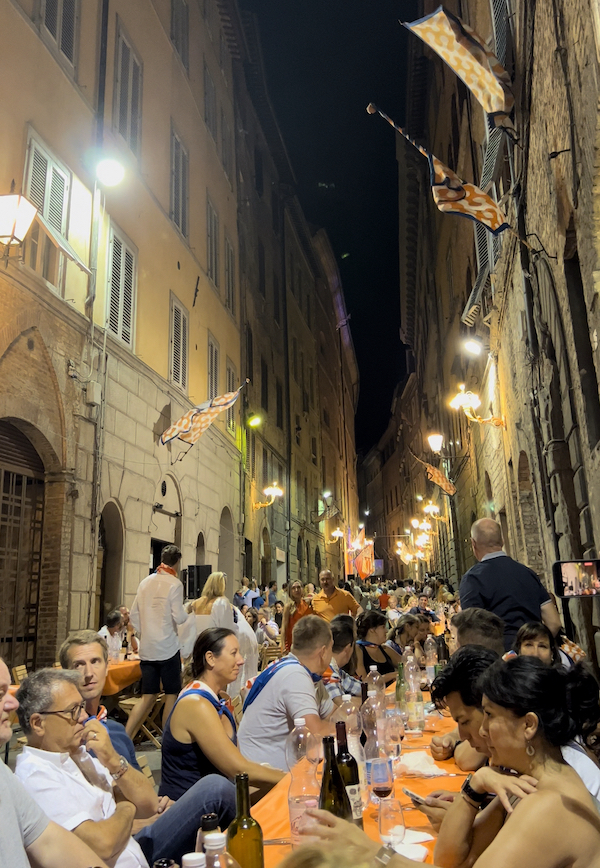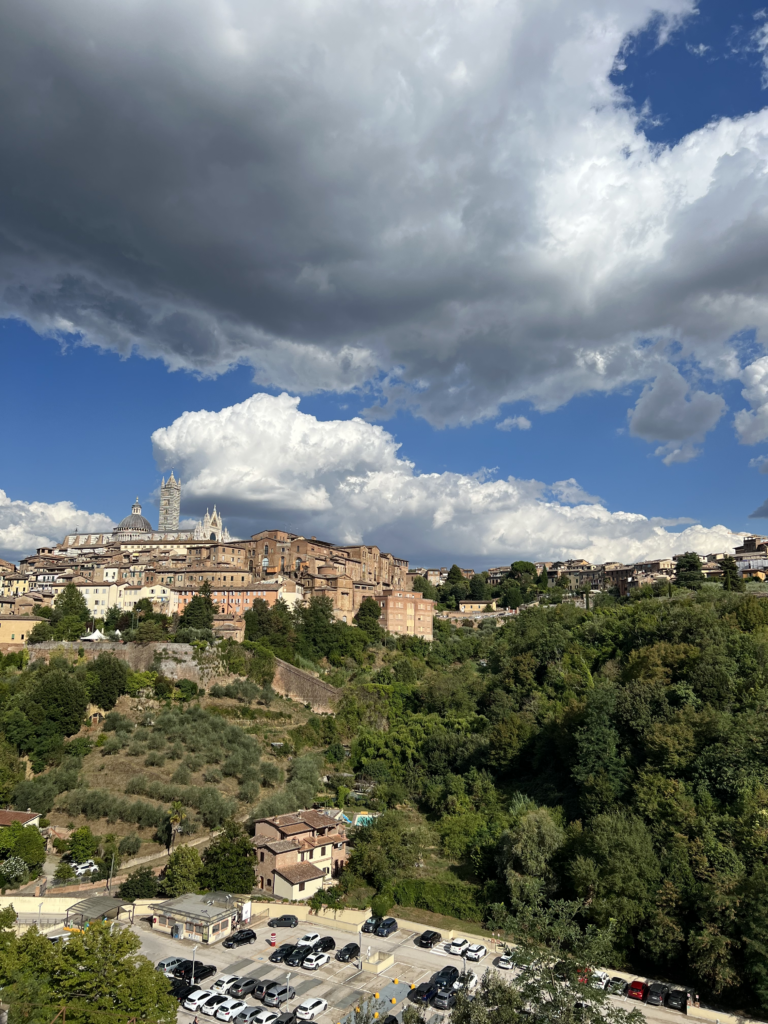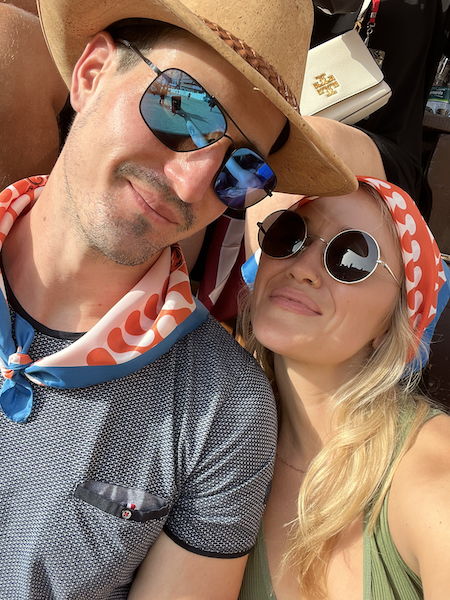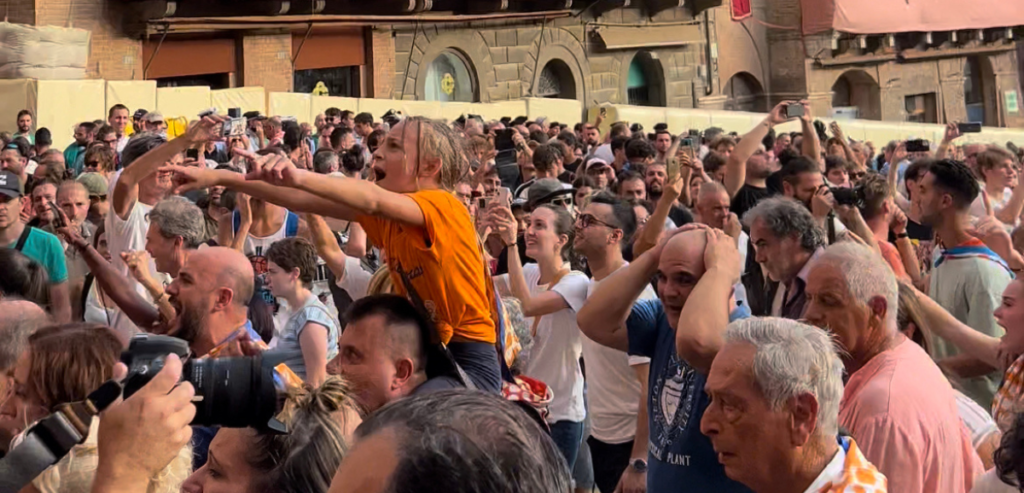One evening in May 2020, my buddy Dave and I drank a bottle of wine and watched “The Palio” documentary. At this point in the pandemic, I had essentially been locked in my apartment alone for two months, so I borrowed the neighbor’s dog to take him for a walk. We walked to Dave’s.
For those of you who don’t know (which is probably most of you, because why would you?), the Palio is one of the oldest and most dangerous horse races in the world. It was first held in 1482 and has been held semiannually on July 2nd and August 16th since 1701.
During the race, the jockeys ride bareback three times around the Piazza del Campo in Siena, Italy, whipping each other and flying off their horses to a screaming (and sometimes sobbing) crowd of 40,000. The race typically lasts 1 ½ minutes or less.
Each “district” has their own team – also known as a contrada. The jockeys and horses are selected at random for each race.
Bribery is at the forefront of the Palio. Each contrada gives their jockey money to bribe and make deals with other jockeys. Historically, jockeys that are suspected of throwing the race suffer beatings at the hands of their contrada.
In Siena, your contrada is part of your identity.
It’s intense.
Ever since that fateful (and illegal) night at Dave’s, we’ve been determined to go to this horse race. We forced my partner Marty to watch the documentary, and he, too, developed a yearning for the hoofbeats of Tuscany. Never mind that tickets are expensive and hard to come by; we were going to experience the passion of the Palio.
And that’s just what we did.
The Contrada Dinner
There’s a contrada dinner the evening before the Palio. At this dinner, the districts allow tourists to dine with the contrada in the streets of Siena to raise money for their bribes and pay their jockey. We were assigned the “Leocorno” contrada (or “Unicorn” for those of you who aren’t yet fluent in Italian).
I read online that it’s polite to buy and wear a fazzoletto – a scarf that matches your contrada – so we popped into a shop before heading to dinner. Although we knew virtually nothing about the politics between the contrada, we wanted to show our support.
We strolled back onto the street sporting our new duds and walked for less than two minutes before being stopped by a thin older woman. She looked at me, pointed at my scarf, and rattled off something in rapid Italian. Her face looked very serious.
Having absolutely no clue what the woman said, I looked at her with wide eyes and responded: “I’m so sorry, my Italian is terrible. English or Spanish?”
Her expression softened slightly. “Your scarf – you are in the enemy territory of your contrada. Do you see the flags? This is Little Owl. This is not where you should be. Go up that street.”
I thanked her, repeatedly, and we shuffled off in the suggested direction. Mildly horrified, I promptly removed my scarf and Dave, Marty and I made our way to dinner.
Let’s Feast
When we arrived at dinner, we were greeted by hundreds of contrada flags, trumpets, and long, picnic-style tables set for at least 400 diners. Our scarves were back in fashion.

People milled about excitedly in front of a large, elevated table where the jockey, contrada captain, and other people of importance would eat and give speeches. Two TVs were set at either end of the dinner so people would have a good view of the head table.
We were mercifully seated with other English-speaking contrada diners, and the wine and conversation flowed freely. One couple, recently engaged, were enjoying the 8th day of their Italian honeymoon after a complicated and exhausting wedding. Another couple celebrated their retirement.
By some beautiful stroke of luck, the jockey for our contrada was Giovanni Atenzi – also known as Tittia – 8-time winner of the Palio and star of the Palio documentary. When he entered, Tittia walked, helmet in hand, in a processional between the tables that lined the street. Flags twirled, trumpets blared, people sang, women squealed; everything you’d expect to experience in the presence of a superstar.
We were served a remarkably delicious 4-course meal, bottled water, and an endless stream of Chianti for 70 euro. Although I typically don’t eat meat, I respectfully wolfed down heaps of prosciutto and steaming wild boar. There are no accommodations made for vegans or vegetarians at the Palio, and I can’t imagine the reaction you’d receive were you thick enough to turn your nose up at their food.
The dinner began to wind down around midnight; not due to lack of entertainment, but because of a rapidly approaching thunderstorm. The sky flickered and people fled, buzz achieved and bottles in hand.
The Lead Up
There are countless complicated traditions leading up to the Palio. Parades through the streets, additional contrada dinners, four practice races (which you can watch for free in the center of the piazza), the blessing of the horses in their respective cathedrals… the list goes on and on.
Should you find the energy to attend all or some of these happenings, you’ll quickly see that the Palio is not a single day event – it’s spread across four days.
We attended one Palio pre-race, crammed into the center of the track with thousands of other people, feeling sweaty and slightly stressed.
Even then, the air was electric, but it paled in comparison to what we saw on race day.

Palio Race Day
The city brings truckloads of sand into the piazza for the Palio, which they pack down until it forms a thick, hard layer over the cobblestones. If it rains, the sand turns into a slick, soggy clay that’s impossible walk on, let alone run a horse across.
Although it had rained the night before, the scorching Tuscan sun had sufficiently dried the sand by the time of the Palio. We took our seats at 4:30pm in the front row of the bleachers at the San Martino bend – i.e. the corner where jockeys are notorious for taking flight – and waited expectantly for the festivities to begin. The race wasn’t scheduled to start until 7:00pm, but we were told that there would be plenty of fanfare in advance.

I was snacking on a caprese sandwich when the decorated calvary emerged from one of the entrance points and started galloping around the track, brandishing silvery swords. Lead by an intimidating woman with a perfectly tight bun, they pointed their swords at an invisible enemy and attacked. As the calvary rounded the bend towards the exit and their show came to a close, rain started to freckle the ground.
Seconds later, the cloud yawning above us let loose. Thousands of people in the center of the piazza just stood there, unable to exit, or move, or do anything but enjoy a good soaking. A few people near us (apparently at risk of melting) screamed. I crawled under the seats of the bleachers and made for the nearest overhang and grabbed a beer.
Within moments, the entire piazza was a pit of mud. The race organizers hung up a green flag indicating that the race would be postponed until tomorrow.
The Race, Round Two
I was admittedly a little happy that the race had been rained out. It extended my adventure in Siena. We were staying in a beautiful, old-fashioned apartment at the edge of the city that was quiet, comforting, and reminded me of my grandparent’s house. The next morning, I took a bubble bath and enjoyed my high-voltage coffee in the tub.
On race day #2, the weather was much more favorable. Well… “favorable” in the sense that it wasn’t raining, anyway. It was humid and 36 degrees (that’s 97 degrees for those of you in the US of A), and our seats were ideal for any sunbathing enthusiast. I forgot to wear sunscreen.
For some unknown reason the race start was moved up 20 minutes, so we piled onto the wooden bleachers at 4:00pm instead of 4:30pm. The center of the piazza was already filled with excited onlookers, and horses were being led around the racetrack by men dressed in hilariously antiquated wigs and brightly colored tights.
Knights in full suits of armor marched dutifully forward, not giving any indication that they were nearing heat stroke. Every few minutes, a jockey would ride past wearing traditional high-fashion robes from the 1700s.
A duo of flag twirlers from each contrada competed for the honor of winning best performance by executing synchronous moves, including one-legged twirls and half-splits.
This remarkable processional continued for two hours, until I was hiding in Marty’s shadow and cursing my fragile skin.

Despite the caricature that was being created, this was not a joke or a lighthearted performance. There was no smiling. The Sienese approached their Palio duties with a prideful seriousness. This was tradition, in its purest, finest form; there was to be no deviation from the plan.
When the track was finally cleared, the piazza began to quiet and the jockeys made their way to the start line. People began to “Shhh!” one another until the anxious crowd was blanketed by a heavy silence. The starting order was to be determined, at random, and announced over a loudspeaker.
“Leocorno, uno!”
Tittia, the best jockey, riding arguably the best horse, had just been given the best spot in the lineup. Our contrada was positioned to win.
A growling murmur spread across the piazza, laced with feverish energy. My hair stood on end.
The rest of the jockeys were announced, in order, until the lineup was completed. Each announcement was echoed by the same uncomfortable rumble.
Unlike most horse races, the Palio is started by a “run-in” jockey, rather than the pop of a gun. The run-in jockey stands behind the line of riders and, as the name would indicate, starts the race when he chooses to run. The run-in jockey rarely wins, but he is in prime position to help or hurt the likelihood of the other jockeys winning. His start is strategic, and the starting line process can take upwards of 30 minutes.
The horses spun around anxiously while the jockeys whispered and bartered with one another. Although we couldn’t hear it, hundreds of thousands of dollars were being verbally exchanged as jockeys attempted to gain leverage or plot against enemy contradas.
All eyes were on the run-in jockey. He sat back, feigning relaxation and looking over the lineup watchfully.
The tension made my teeth ache.
I suddenly realized that I wasn’t just excited – I was scared. For the jockeys, the horses, the emergency responders lining the sidelines. For the unpredictability of the course and the chaos that would inevitably ensue.
The starting line dissolved into disorder and the jockeys were forced to exit and reenter, effectively resetting the start line. The horses stomped, kicked, and tossed their heads in irritable anticipation. Minutes passed as my heartbeat thudded in my ears.
And then, seeing the perfect opening, the run-in jockey pounced.
The piazza erupted in a thundering scream.
Leocorno immediately took the lead, holding tight to the inside of the track. The other jockeys followed, mere hoofbeats behind. As they rounded our corner, the horses desperately surged forward and mud rained into my hair.
Pushed to breakneck speeds, two of the horses collided on a narrow turn and three jockeys flew off their horses and onto the track. One of the jockeys covered his head as hooves pummeled him.
I watched with awe and horror as the emergency responders swept in and pulled the jockeys from the piazza. Unharmed, their horses continued the sprint for the finish line. (Strangely enough, riderless horses can win the Palio.)
Tittia created a sizeable gap between himself and the other jockeys at the beginning of the second lap. The crowd at the center of the piazza seemed to pulse with urgency.
Riderless horses whipped by, wreaking havoc in their wake. Without the guidance of a jockey, their movements were dangerous and erratic.
On the final turn, Tittia raised his hand in the air and yelled, knowing he was victorious. Spectators jumped the barriers and poured onto the track, horses still galloping wildly towards the finish.
The closing cannon erupted and people screamed. Screams of victory, of agony, of relief. Leocorno flags paraded into the piazza while supporters of Little Owl (the enemy contrada) ran towards the exit, howling. A girl on the track let loose a guttural, animal scream that was unlike anything I’d ever heard.
The emotion was so incredible, raw, and real. It was a little unnerving.
A couple seated next to us decided to join the celebration on the track and were immediately confronted by a wild horse. They jumped back into the bleachers sheepishly.
I stood there, watching the Sienese tears flow, wondering if I’d ever cared about anything with such intensity. I shared but a fraction of their passion, and still felt the inexorable power of the Palio.
The jockeys were released from the hospital the next day.
The Palio is a snapshot of history. It reminds us of the birth of competition – of tradition, and of sacrifice. Not so long ago, entertainment relied upon the collective experience of risk and danger. That memory lives on in the Palio.
Want to watch the whole race? You can see it here.
Got the travel bug? Send me a message to learn more about the Palio or join me at my yoga retreat in Costa Rica in March, 2023.





